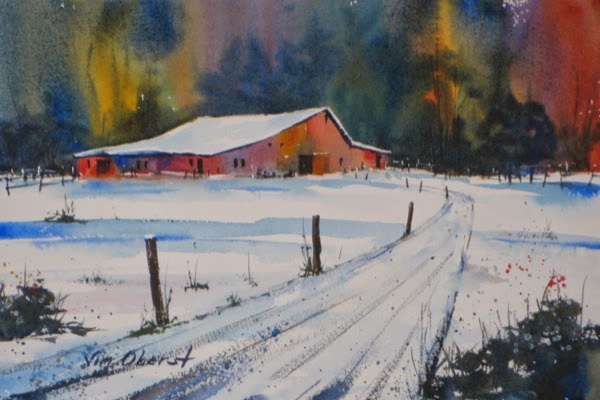The simplest is to show shapes getting smaller in the distance. A special case of this effect, which is very effective, is to show lines converging in the distance. Both of these effects can be seen in the painting Seine-Side Booksellers. Here, the people in the distance are much smaller than those in the mid-ground. And the parallel "lines" on the sidewalk converge as they retreat into the distance. These are direct results of applying linear perspective to our paintings. This painting is an example of single-point perspective (there is only one vanishing point).
Another depth-creating illusion is to show evenly-spaced objects getting closer together as they recede into the distance. This can be seen in the fence posts in the painting Winter Farm:
 Even though the largest 3 posts seem equally spaced, if you measure the distance between them, you'll see that the closest two are spaced about twice the distance of the 2nd and 3rd posts. And each post is about half as high as the one preceding it. Here we also see the converging lines of the snow-covered road as it recedes. Note the very great degree of convergence here... in the foreground, the width of the road is over 2/3 the width of the painting, while around halfway "up", it is less than 1/15th the width. One thing to keep in mind is that it is nearly impossible for the artist to make items in the foreground too large!
Even though the largest 3 posts seem equally spaced, if you measure the distance between them, you'll see that the closest two are spaced about twice the distance of the 2nd and 3rd posts. And each post is about half as high as the one preceding it. Here we also see the converging lines of the snow-covered road as it recedes. Note the very great degree of convergence here... in the foreground, the width of the road is over 2/3 the width of the painting, while around halfway "up", it is less than 1/15th the width. One thing to keep in mind is that it is nearly impossible for the artist to make items in the foreground too large!
Another method for creating the illusion of distance is to manipulate the contrast, texture, and color temperature of objects at different distances. Take a look at the painting Sleepy Valley:
The colors get cooler in the distance - bluer trees and grass and purple hills. They get warmer in the foreground, tending from green toward brown. The distant objects have a soft texture and little contrast, while the textures get harder and rougher as the foreground is approached. The result is a definite feeling of great distance in this 2-dimensional painting.
Here's another example... the painting Lobstah...
The hills and water in the background have been painted very soft, while the boat in the mid-ground is well-defined with good contrast and detail, and the water in the foreground has significant texture in the rough-brushed marks.
So, for a realistic painter, perhaps the most important illusion to create is that of depth, so that the viewer is drawn into the painting as though it were 3-dimensional, and can develop a sense of actually "being there".
If you'd like to get Artist and Art Collector Tips like this delivered directly to your inbox, sign up for my fine art e-newsletter here! When you subscribe, you'll receive a 10% instant rebate valid for one month for any of my paintings.




No comments:
Post a Comment